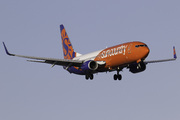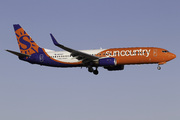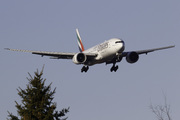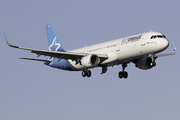Dépêches
Fitch Downgrades UAL & United to 'CCC' on Continuing Revenue & Liquidity Concerns
Dépèche transmise le 10 juin 2009 par Business Wire
CHICAGO--(BUSINESS WIRE)--Fitch Ratings has downgraded the debt ratings for UAL Corp. (UAL) and its principal operating subsidiary United Airlines, Inc. (United) as follows:
UAL
--Issuer Default Rating (IDR) to 'CCC' from 'B-'.
United
--IDR to 'CCC' from 'B-';
--Secured bank credit facility (Term Loan and Revolving Credit Facility) to 'B+/RR1' from 'BB-/RR1';
--Senior unsecured debt to 'C'/RR6 from 'CCC'/RR6.
The credit facility rating applies to approximately $1.3 billion of term loan debt, and the unsecured rating applies to approximately $876 million of outstanding convertible notes. Fitch no longer maintains a Rating Outlook for UAL and United.
The downgrade reflects Fitch's view that the airline's credit profile is likely to weaken further, as extreme pressure in the revenue environment continues to undermine the positive cash flow impact of lower jet fuel prices in 2009. Despite preliminary signs of a moderation of year-over-year deterioration in passenger yields and revenue per available seat mile (RASM) in April, the revenue picture appeared to worsen again in May as H1N1 flu concerns depressed industry bookings further. Although domestic leisure-oriented demand is holding up reasonably well as the recession continues, passenger yield and RASM trends in premium business travel markets will likely improve only slowly as the economy strengthens somewhat moving into 2010.
Fitch expects United's operating results and free cash flow generation to remain weak through the remainder of the year, largely as a result of its heavy exposure to premium business markets that have seen the steepest declines in passenger yields and RASM following the rapid pull-back in corporate travel spending that accelerated late in 2008 and into the first quarter of 2009. Trans-Atlantic and trans-Pacific RASM trends are expected to be especially weak this summer as carriers discount seats aggressively to maintain good load factors on a lower available seat mile (ASM) capacity base. Even in domestic markets, revenue pressure is likely to continue on higher-yielding trans-continental routes where United has significant exposure. In spite of the early and significant rationalization of capacity undertaken by United and the rest of the industry in 2008, unit revenue pressure has remained intense this year as the full impact of the global recession on premium travel demand has become clear.
Passenger RASM declines in excess of 19% reported by both Continental and US Airways for the month of May suggest that the industry revenue environment is not stabilizing in line with other consumer spending and macroeconomic indicators. Rather, Fitch is increasingly concerned that a continuation of weak revenue patterns through the summer could erode much of the industry's cash flow generation potential for 2009. For United, with a large presence in the weakest business markets, Fitch believes that a slow second-half revenue recovery scenario could drive full-year passenger RASM declines of more than 10%.
United's free cash flow outlook, while supported by the recent reduction of its full-year capital spending plan to $350 million from $450 million, has been pressured significantly by the ongoing revenue softness.
Factoring in only a slow moderation of unit revenue deterioration in the second half of the year, Fitch believes that United could report substantially negative free cash flow for the final three quarters of 2009. While negative free cash flow margins will improve significantly over 2008, Fitch believes that internal cash generation alone will not be sufficient to prevent an erosion of the carrier's unrestricted liquidity position by year end.
Despite the absence of near-term aircraft capital commitments, United does face steady and heavy debt maturities that will require the carrier to generate positive free cash flow over time. As of April 21, 2009, United reported scheduled maturities of debt and capital leases totaling $655 million for the final three quarters of 2009. Even if revenue trends stabilize late in the year, the airline faces over $1 billion in scheduled debt and capital lease principal payments next year, raising the probability of a deepening liquidity crisis. Looking beyond 2010, the airline must meet scheduled debt maturities of $869 million in 2011. Given its heavy fixed financing obligations, and in light of the carrier's poor near-term cash flow generation capacity, Fitch views United's highly-leveraged capital structure as unsustainable in the absence of a sharp turnaround in industry operating fundamentals.
Substantial year-over-year fuel cost savings continue to offset much of the intense revenue pressure that has been felt in the first half of the year. Despite the recent run-up in energy prices, with crude oil topping $70 per barrel by early June, United will realize significant cash savings this year. Based on current futures prices, Fitch estimates that United could realize over $3.5 billion in full year fuel expense reduction in addition to cash savings linked to the return of cash collateral held by fuel hedge counter-parties. United indicated in April that it expected $940 million of the $965 million in fuel hedge collateral posted as of year-end 2008 to be returned by the end of this year. During the first quarter alone, lower fuel hedge collateral drove $395 million in operating cash inflows (offset in part by $286 million in outflows tied to net changes of fuel derivatives and related pending settlements). As United's fuel hedge position diminishes through the remainder of the year, the carrier's fuel expenses will become more closely tied to changes in the spot price of jet fuel.
Liquidity was supplemented by extensive capital raising activity in the first quarter and some positive operating cash flow swings linked to hedge collateral changes, proceeds from the amendment of an airport lease agreement and normal seasonal increases in the air traffic liability. Total unrestricted cash of $2.5 billion as of March 31, 2009 represented approximately 13% of latest twelve months revenues. In addition to cash on hand, management has indicated that an estimated $1.7 billion in remaining unencumbered assets could be used to improve liquidity in the future. However, since much of the unencumbered asset base (e.g., older aircraft and engines) cannot be easily monetized, Fitch believes that United may have difficulty raising a large amount of new capital over the near-term as credit market conditions remain very tight.
The need to comply with credit facility financial covenants, suspended for four quarters after United negotiated an amendment with lenders during the 2008 fuel crisis, resumes in the current quarter. With respect to the most binding EBITDAR fixed charge coverage covenant, the airline must meet a 1.0 times (x) coverage requirement for the three months ending June 30, 2009. The requirement steps up to 1.1x for the six months ending Sept. 30, 2009 and 1.2x for the nine months ending Dec. 31, 2009. As defined in the credit facility agreement, calculated EBITDAR in the fixed charge ratio's numerator is adjusted for a number of special items, including frequent flyer revenue items. By definition, the calculation includes GAAP fuel expense, which captures the impact of fuel hedge gains as hedge collateral is returned. Fixed charges in the denominator are defined as cash interest payments plus cash aircraft rents. This figure excludes non-cash items such as those associated with the recent accounting change related to the treatment of convertible debt.
Given its extremely high lease-adjusted leverage, United has no flexibility to finance new aircraft over the near-term, and its no-growth fleet and capacity plan reflects a need to de-lever the balance sheet before any new aircraft capital spending can occur. Reports of United's interest in the initiation of a widebody order competition between Boeing and Airbus, in Fitch's view, reflect a longer-term need to replace aging widebody aircraft over the next several years. As a result, this development has no short-term implications for United's credit profile or ratings. Successful financing of such a large multi-year order, in Fitch's opinion, would require a significant improvement in United's credit profile and the industry operating environment.
A downgrade of the IDR to 'CC' or 'C' could follow in a scenario where United's unrestricted liquidity approaches $1.5 billion later this year or in 2010. Liquidity pressure of this magnitude could result from a further deterioration of demand and unit revenue trends in the second half of the year. A material energy price shock, while less likely, could also pressure cash flow further and drain cash from the airline.
Fitch's rating definitions and the terms of use of such ratings are available on the agency's public site, www.fitchratings.com. Published ratings, criteria and methodologies are available from this site, at all times. Fitch's code of conduct, confidentiality, conflicts of interest, affiliate firewall, compliance and other relevant policies and procedures are also available from the 'Code of Conduct' section of this site.
- 15:33 Friedrichshafen 2024 : Splash-in Aviation expose son Pétrel X
- 07:25 Friedrichshafen 2024 : Robin "toujours présent et pour longtemps"
- 07:11 Friedrichshafen 2024 : Beringer présente au salon
- 07:01Friedrichshafen 2024 : la FFPLUM dément le passage de tous les ULM 3 axes à 600kg
- 06:44 Friedrichshafen 2024 : visite d'un Pilatus PC-12 (photos)
- 17/04 Friedrichshafen 2024 : Cirrus Aircraft présente son SR G7
- 17/04 Friedrichshafen 2024 : Piper présente son M700 Fury
- 17/04 Friedrichshafen 2024 : Junkers dévoile son A50 Heritage
- 17/04 Friedrichshafen 2024 : la société E-Props présente au salon
- 17/04 Le 30e salon de Friedrichshafen a ouvert ses portes
- 15/04 Airbus : commandes et livraisons de mars 2024
- 15/04 easyJet renforce ses dessertes depuis la France vers Budapest
- 15/04 Vueling inaugure sa liaison entre Orly et Heathrow
- 12/04 British Airways ouvre les candidatures pour son programme cadets Speedbird Pilot Academy
- 12/04 Icelandair et Expedia annoncent un nouveau partenariat
- 12/04 Turkish Airlines : résultats 2023
- 12/04 easyJet annonce deux nouvelles lignes depuis Lyon
- 12/04 Le premier Embraer E190 P2F fait son vol inaugural
- 12/04 Volotea obtient l'agrément complet pour son Système de Management de la Sécurité
- 12/04 easyJet et l'UNICEF lancent la campagne "Every Child Can Fly"







